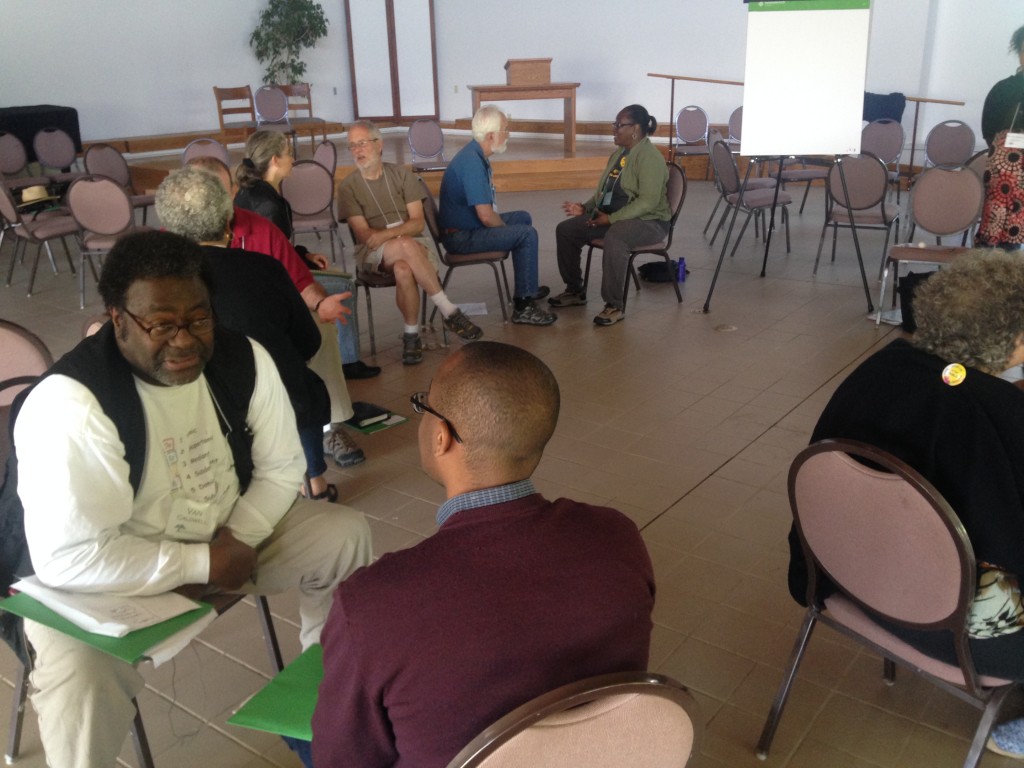Sessions at Coming to the Table are rarely easy. Despite the time separating current Americans from the era of legal slavery in the United States, the wounds of racial injustice remain fresh for the descendants of slaves, especially in the face of ignorance or denial of these wounds.
At the 2014 annual meeting of Coming to the Table, two participants read emotionally charged poems that they exchanged after learning they were descended from the same plantation in Missouri. During one discussion, a participant of European origins shared her suspicions that the systematic abuse in her family was a legacy of the psychological impact of owning slaves.
More than 150 years after the end of slavery, the historical trauma of a system that turned people into property remains throughout the nation. It’s a trauma that members of Coming to the Table are trying to address through a four-step process:
(1) uncovering and acknowledging history,
(2) making deep connections across racial lines,
(3) working toward healing together, and
(4) taking action to make systemic and institutional change to end racial inequality and injustice.
Conference was at capacity
Coming to the Table held its 2014 national gathering May 23-25 at Eastern Mennonite University, a site chosen in recognition of the organization’s birth at EMU in 2006. EMU professor and restorative justice expert Howard Zehr joined this year’s meeting for a keynote talk – he was also present at the 2006 gathering. The 2014 gathering occurred on a weekend break in EMU’s annual Summer Peacebuilding Institute. Some participants extended their time at EMU to take institute courses.
Initially Coming to the Table focused mainly on exploring the stories and experiences of people linked by their ancestors’ enslaved-slaveholding relationship. But the group’s focus has expanded far beyond this over the last eight years.
With 80 enrollees, the 2014 conference was at capacity, said organizers. During the three days participants focused on each of the four steps in the change process.
Taking four steps
As an opening activity, participants created a map that highlighted linkages, including shared ancestry. They deepened their connections during workshops and activities, which included light-hearted events like shared meals and a talent show. As a step toward healing, people of both races dialogued about their encounters with privilege and discrimination. For the taking action step, participants discussed ongoing economic and social discrimination in areas like the criminal justice system, and they wrestled with how to tackle these problems.
Two members of Coming to the Table – Sharon Morgan, who is black, and Tom DeWolf, white – met at one of its early gatherings and eventually co-authored Gather at the Table: The Healing Journey of a Daughter of Slavery and a Son of the Slave Trade (Beacon Press, 2012). The book describes their painful yet ultimately hopeful journey over a three-year period, covering thousands of miles through 27 states and beyond the U.S. border.
“We embarked on this journey because we believe Americans must overcome the racial barriers that divide us, the barriers that drive us to strike out at one another out of ignorance and fear,” they explained in their book. “To do nothing is unacceptable to us. The legacy of slavery remains a horrendous and unhealed wound, a disease that must be diagnosed, treated and cured.”
Interviewed at the 2014 conference, Morgan, a genealogist, said Coming to the Table has “gone beyond [genetic] linkages because it is difficult for many descendants of enslaved people to find reliable genealogies.”
Coming to the Table was launched with a four-day gathering in January 2006 at EMU. The idea for the gathering came from Will Hairston, EMU’s supervisor of grounds, and Susan Hutchison, both white descendants of significant American enslaving families.
Words from Martin Luther King Jr.
Phoebe Kilby, a white woman who raises funds for EMU’s Center for Justice and Peacebuilding, followed in Hairston’s footsteps and became an early member of Coming to the Table after discovering connections with the descendants of slaves on a farm owned by her ancestors. She got in touch with Betty Kilby Baldwin, an African-American woman who wrote Wit, Will & Walls (Cultural Innovations Inc., 2002). They now call each other cousins.
As seed money, Coming to the Table received grants from The Fetzer Institute and the Kellogg Foundation and initially was formally a program of EMU. Since then, the group has moved toward more autonomy while maintaining an EMU affiliation. It has attracted growing interest, with a mailing list of 985 persons and a Facebook group with over 1,100 members.
The name “Coming to the Table” is inspired by Martin Luther King, Jr.’s historic March on Washington speech, in which he prayed that one day “…the sons of former slaves and the sons of former slave owners… will be able to sit down together at the table of brotherhood.”
